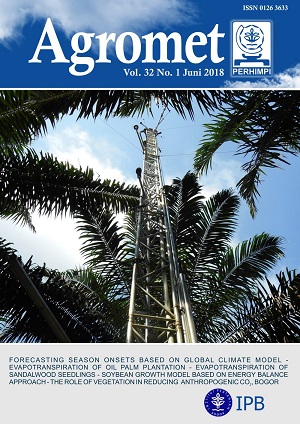Forecasting Season Onsets in Kapuas District Based on Global Climate Model Outputs
Abstract
Predictions of the rainy and dry season onsets are very important in climate risk management processes, especially for the development of early warning system of land and forest fires in Kalimantan. This research aims to predict the rainy and dry season onsets in two cluster regions in Kapuas District, Central Kalimantan. The prediction models used to predict the onsets are developed by using seasonal rainfall data on September-October-November (SON) periods as predicted by five Global Climate Models (GCMs). The model uses Canonical Correlation Analysis (CCA) method available in the Climate Predictability Tool (CPT) software developed by the International Research Institute for Climate and Society (IRI), Columbia University. The results show that the predictors from HMC and POAMA models produce better canonical correlations (r = 0.72 and 0.89, respectively) compared to BCC (r=0.46), CWB (r=0.62), and GDAPS_F (r=0.67) models. In the development of models for predicting the dry season onsets, the predictors from CWB and POAMA models perform better canonical correlation results (r = 0.73 and 0.76, respectively) compared to BCC (r=0.53), GDAPS_F (r=0.64), and HMC (r=0.46) models. In general, the model validations showed that CWB, GDAPS_F, and POAMA models have better predictive skills than BCC and HMC models in predicting onsets of the rainy and dry seasons (with Pearson correlations (r) ranging between 0.30 and 0.75). Experiments on those five models for the predictions of rainy season onset in 2013 showed that the predicted onsets occurred on the range of 8 September to 22 October in Cluster 1 and on 3 to 7 October in Cluster 2. For the predictions of the dry season onsets in 2014, the models predicted the occurrences from 6 to 25 May in Cluster 1 and from 21 to 25 March in Cluster 2.
Authors
NurdiansyahL., & FaqihA. (2018). Forecasting Season Onsets in Kapuas District Based on Global Climate Model Outputs. Agromet, 32(1), 1-10. https://doi.org/10.29244/j.agromet.32.1.1-10
Copyright and license info is not available

